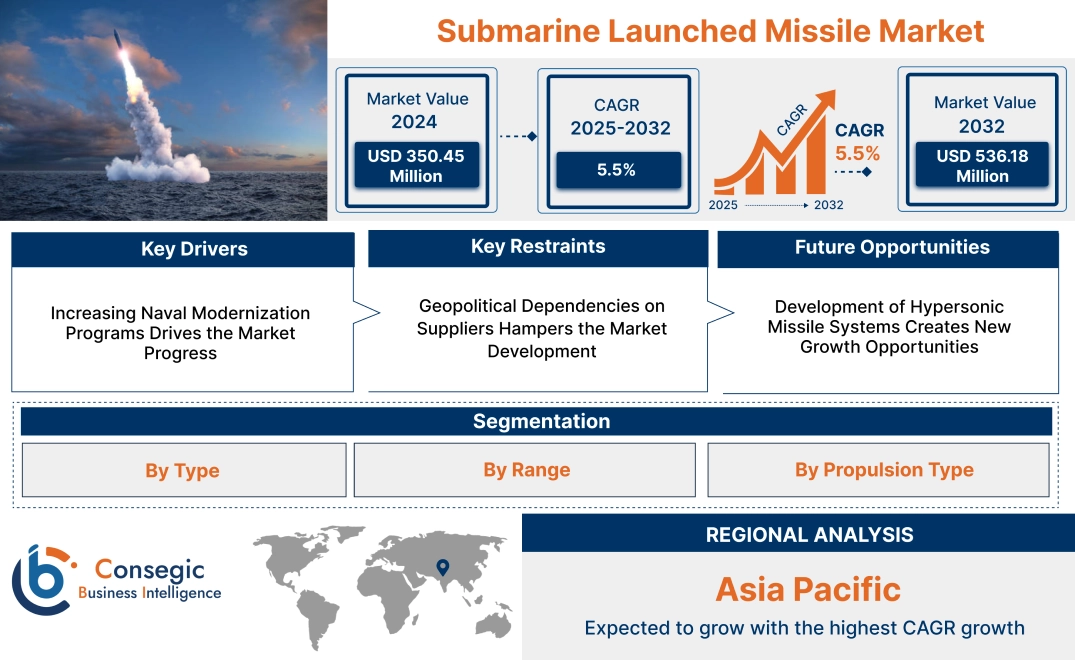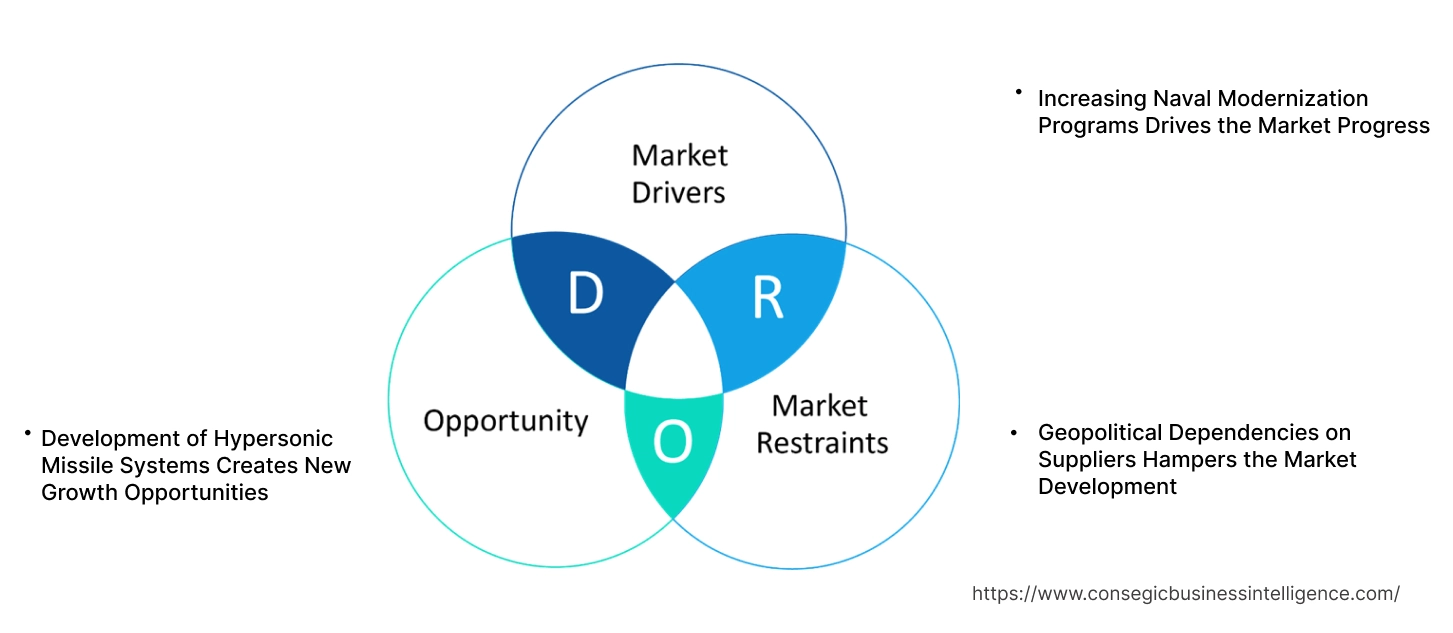- Summary
- Table Of Content
- Methodology
Submarine Launched Missile Market Size:
Submarine Launched Missile Market size is estimated to reach over USD 536.18 Million by 2032 from a value of USD 350.45 Million in 2024 and is projected to grow by USD 363.34 Million in 2025, growing at a CAGR of 5.5% from 2025 to 2032.
Submarine Launched Missile Market Scope & Overview:
The submarine launched missile focuses on missile systems designed to be deployed from submarines for strategic and tactical applications. These missiles are engineered to function effectively in underwater environments, offering capabilities for both offensive and defensive operations. They serve as critical components of naval defense systems, providing enhanced stealth and operational flexibility.
These missile systems are available in various types, including ballistic and cruise missiles, tailored to meet specific mission requirements. They are equipped with advanced navigation, guidance, and propulsion technologies to ensure accuracy and effectiveness. Designed for high reliability, these missiles operate under challenging conditions, ensuring performance during critical missions.
End-users include naval forces and defense contractors seeking advanced solutions for strengthening maritime security and enhancing submarine-based strike capabilities. These systems play a vital role in modernizing naval arsenals and ensuring strategic defense readiness.
Key Drivers:
Increasing Naval Modernization Programs Drives the Market Progress
Increasing naval modernization programs are driving the adoption of advanced missile-equipped submarines to bolster maritime defense capabilities. Governments globally are prioritizing the development and deployment of state-of-the-art submarines integrated with precision missile systems to enhance strike accuracy and operational readiness. These initiatives are particularly evident in regions with rising geopolitical tensions, where maritime dominance plays a critical role in national security strategies.
Investments in next-generation platforms, such as nuclear-powered submarines and air-independent propulsion systems, further underline the focus on extending operational endurance and stealth capabilities. By integrating cutting-edge missile technologies, including ballistic and cruise variants, navies aim to improve deterrence and rapid-response capabilities in critical maritime zones. This trend reflects the growing emphasis on strengthening naval fleets as a key component of comprehensive defense strategies, fostering the demand for advanced missile systems tailored for submarine platforms, which further drives the submarine launched missile market growth.
Key Restraints:
Geopolitical Dependencies on Suppliers Hampers the Market Development
Geopolitical dependencies on foreign suppliers pose a significant constraint to the development and deployment of submarine-launched missile systems. Many nations rely on external sources for critical components, such as advanced propulsion systems, guidance technologies, and missile warheads. In regions with heightened geopolitical tensions or strained diplomatic relations, access to these essential resources becomes uncertain.
Export restrictions, trade embargoes, or shifts in supplier priorities disrupt supply chains and delay project timelines, limiting a country’s ability to modernize its naval capabilities. This dependency creates vulnerabilities, as reliance on external suppliers leads to compromises in system customization or security. Nations aiming to maintain strategic autonomy face significant hurdles in mitigating these risks, especially in the highly specialized and technologically advanced domain of submarine-launched missiles. These restraints underscore the importance of robust domestic manufacturing capabilities and diversified supplier networks. Therefore, the aforementioned factors are limiting the submarine launched missile market demand.
Future Opportunities :
Development of Hypersonic Missile Systems Creates New Growth Opportunities
The development of hypersonic missile systems is revolutionizing underwater combat, creating significant opportunities for manufacturers. Hypersonic missiles, capable of exceeding Mach 5, offer unparalleled speed and precision, making them highly effective for strategic strikes. These technologies enable submarine-launched missiles to evade existing missile defense systems, enhancing their lethality and stealth capabilities.
Advancements in materials science, propulsion systems, and thermal management are driving the feasibility of integrating hypersonic systems into submarine platforms. As nations prioritize next-generation weapons to strengthen their deterrence capabilities, demand for hypersonic submarine-launched missile systems is expected to rise. This development also fosters innovation in guidance systems, underwater launch mechanisms, and system miniaturization, further redefining the role of submarines in modern naval warfare. The adoption of hypersonic technology represents a transformative shift, positioning manufacturers to capitalize on the growing emphasis on speed, precision, and advanced defense strategies in maritime operations. Thus, as per the market analysis, the development of hypersonic missiles is boosting submarine launched missile market opportunities.
Submarine Launched Missile Market Segmental Analysis :
By Type:
Based on type, the market is segmented into ballistic missiles and cruise missiles.
The ballistic missiles segment accounted for the largest revenue of the total submarine launched missile market share in 2024.
- Ballistic missiles are preferred for their capability to carry heavy payloads over long distances, making them vital for strategic defense.
- Their deployment by major defense forces worldwide for deterrence and strike capabilities strengthens this segment's dominance.
- Technological advancements, including improved navigation systems and faster reentry speeds, further support the widespread adoption of ballistic missiles.
- The rising emphasis on modernizing naval capabilities and integrating advanced missile systems drives the segment’s significance, contributing to the submarine launched missile market expansion.
The cruise missiles segment is expected to register the fastest CAGR during the forecast period.
- Cruise missiles are extensively used for precision strikes, offering enhanced accuracy and reduced collateral damage.
- Their capability to operate at low altitudes and evade radar detection has led to their increasing deployment in tactical operations.
- Integration of AI and advanced propulsion systems enhances the operational efficiency of cruise missiles.
- As per the submarine launched missile market analysis, the segment's growth is fueled by the demand for advanced missile systems in asymmetric warfare and counter-insurgency operations.
By Range:
Based on range, the market is segmented into short-range (up to 1,000 km), medium-range (1,000-3,000 km), intermediate-range (3,000-5,500 km), and intercontinental (above 5,500 km).
The intercontinental range segment held the largest revenue of the total submarine launched missile market share in 2023.
- Intercontinental missiles are critical for long-range deterrence strategies, providing strategic depth and global strike capabilities.
- Their ability to carry multiple independently targetable reentry vehicles (MIRVs) enhances their operational efficiency.
- Investments in modernizing intercontinental ballistic missile (ICBM) systems by major defense powers solidify this segment's dominance.
- As per the submarine launched missile market trends, the demand for extended-range missiles to address evolving geopolitical threats further supports this segment's prominence.
The medium-range segment is expected to register the fastest CAGR during the forecast period.
- Medium-range missiles are increasingly deployed for regional security and deterrence, especially in areas with heightened tensions.
- Their versatility in carrying conventional and nuclear payloads makes them suitable for diverse strategic applications.
- The segment benefits from advancements in propulsion technologies, improving range and payload delivery accuracy.
- Thus, rising investments by emerging economies in strengthening their missile capabilities contribute to the segment's rapid growth, which further fuels the submarine launched missile market demand.
By Propulsion Type:
Based on propulsion type, the market is segmented into solid-propellant, liquid-propellant, and hybrid-propellant.
The solid-propellant segment accounted for the largest revenue of 59.5% share in 2024.
- Solid-propellant missiles offer quick launch readiness, making them highly suitable for deterrence strategies.
- Their enhanced storage stability and reduced maintenance requirements drive their adoption in modern naval forces.
- Technological advancements in composite materials for propellants improve performance and reduce production costs.
- Therefore, the market analysis shows that the segment's dominance reflects the shift toward low-maintenance and highly reliable missile systems, driving the submarine launched missile market growth.
The hybrid-propellant segment is expected to register the fastest CAGR during the forecast period.
- Hybrid-propellant missiles combine the benefits of solid and liquid propellants, offering improved efficiency and flexibility.
- Increasing R&D investments in hybrid propulsion systems enhance performance and reduce environmental impact.
- Their potential for adapting to varying mission requirements supports their growing adoption across naval forces.
- As per the submarine launched missile market analysis, the segment's growth is driven by the increasing emphasis on developing next-generation missile technologies.
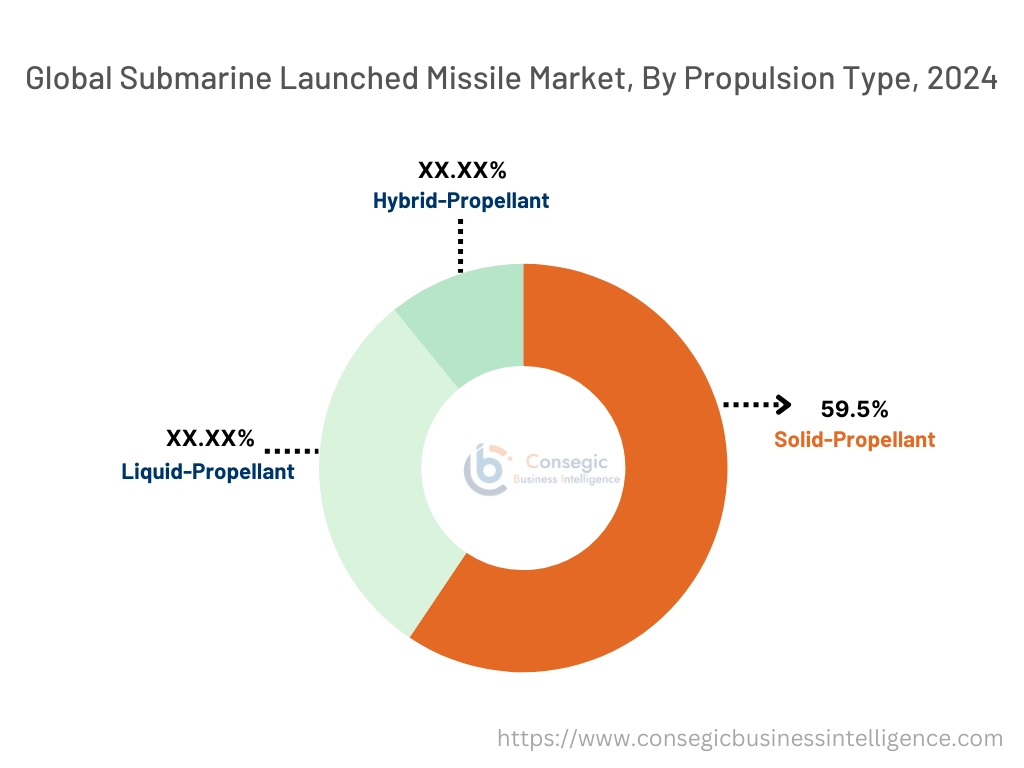
Regional Analysis:
The regions covered are North America, Europe, Asia Pacific, the Middle East and Africa, and Latin America.
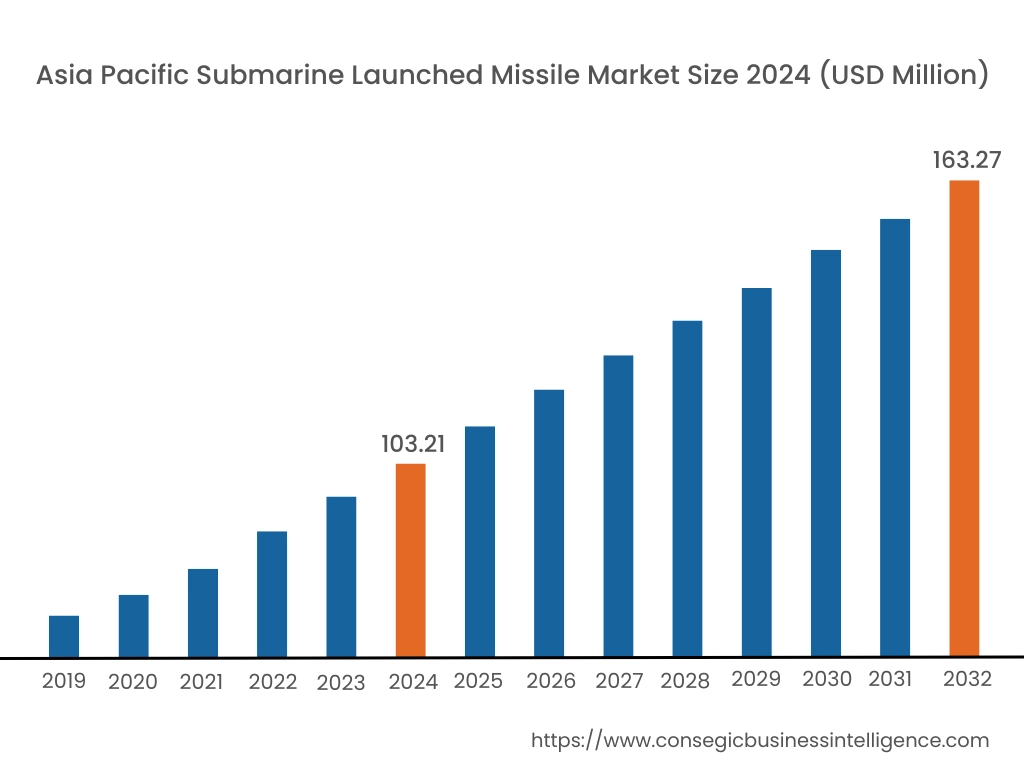
Asia Pacific region was valued at USD 103.21 Million in 2024. Moreover, it is projected to grow by USD 107.31 Million in 2025 and reach over USD 163.27 Million by 2032. Out of this, China accounted for the maximum revenue share of 29.8%. The Asia-Pacific region is witnessing a surge in interest in submarine-launched missile capabilities, driven by regional security concerns and the desire to enhance strategic deterrence. Countries such as China and India are investing in the development and deployment of indigenous SLBMs and SLCMs to strengthen their naval power. A prominent trend is the focus on extending missile range and improving stealth features to evade detection. Analysis suggests that regional tensions and the pursuit of power projection are key factors influencing submarine-launched missile market expansion in this area.
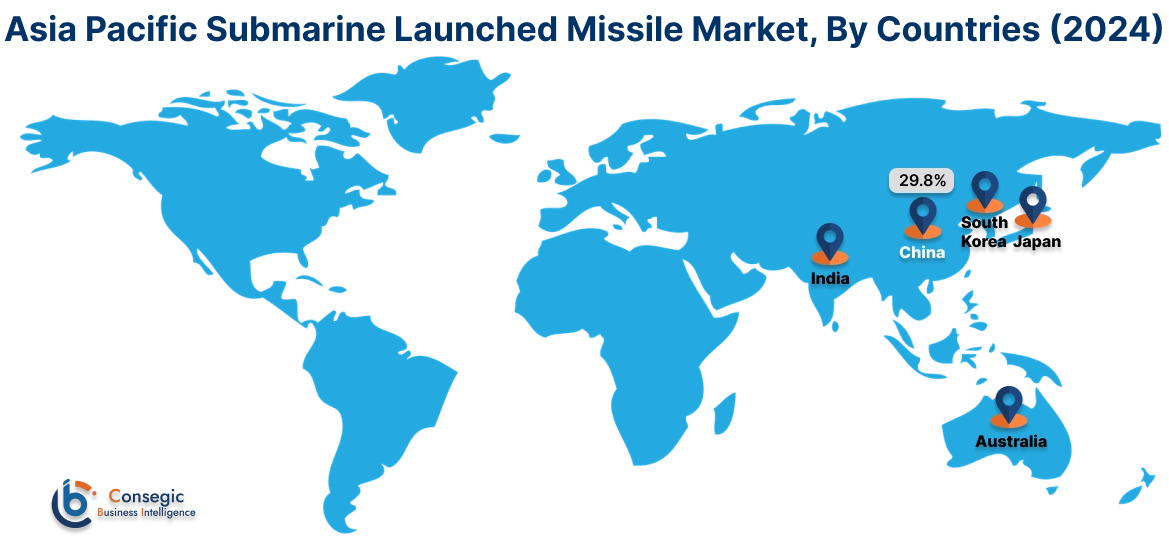
North America is estimated to reach over USD 173.77 Million by 2032 from a value of USD 116.25 Million in 2024 and is projected to grow by USD 120.29 Million in 2025. This region holds a significant share of the submarine launched missile market, primarily due to substantial investments in naval defense and the presence of key industry players. The United States, in particular, emphasizes the modernization of its submarine fleet, incorporating advanced missile technologies to enhance strategic deterrence capabilities. A notable trend is the development and deployment of submarine-launched ballistic missiles (SLBMs) equipped with multiple independently targetable reentry vehicles (MIRVs), enhancing strike precision and effectiveness. Analysis indicates that ongoing research and development efforts, coupled with defense budget allocations, continue to drive submarine launched missile market opportunities in this region.
European nations, including the United Kingdom, France, and Germany, are actively investing in submarine-launched missile systems to bolster their naval capabilities. The region's focus on maintaining a credible deterrent force has led to the adoption of advanced SLBMs and sea-launched cruise missiles (SLCMs). A significant trend is the collaboration among European defense contractors to develop next-generation missile technologies, enhancing interoperability and strategic reach.
In the Middle East and Africa, there is a growing recognition of the strategic importance of submarine-launched missile systems for national defense. Nations are exploring the acquisition of such capabilities to enhance their deterrence posture amidst regional conflicts and security challenges. A notable trend is the interest in procuring advanced missile technologies through international partnerships and defense collaborations, which drives the market growth in this region.
Latin American countries are gradually exploring the development of submarine-launched missile capabilities to strengthen their naval forces. As per the submarine launched missile market trends, the focus on modernizing military assets has led to interest in acquiring advanced missile systems. A significant trend is the collaboration with international defense firms to enhance technological expertise and operational readiness.
Top Key Players and Market Share Insights:
The submarine launched missile market is highly competitive with major players providing products and services to the national and international markets. Key players are adopting several strategies in research and development (R&D), product innovation, and end-user launches to hold a strong position in the global submarine launched missile market. Key players in the submarine-launched missile industry include -
- Lockheed Martin Corporation (USA)
- Northrop Grumman Corporation (USA)
- Naval Group (France)
- Mitsubishi Heavy Industries, Ltd. (Japan)
- Saab AB (Sweden)
- Raytheon Technologies Corporation (USA)
- Boeing Defense, Space & Security (USA)
- General Dynamics Corporation (USA)
- BAE Systems plc (UK)
- Thales Group (France)
Recent Industry Developments :
- In November 2024, MBDA introduced the Exocet SM40, a submarine-launched anti-ship missile designed for modern naval warfar It features advanced J-band RF seekers, enhanced target discrimination, and a turbojet engine for a doubled range of 120 km. Retaining the SM39's underwater launch capabilities, it ensures precision in all weather and electronic warfare conditions. The SM40 provides enhanced self-protection and anti-submarine warfare capabilities, solidifying MBDA's position as a leading European provider of submarine-launched missiles.
Submarine Launched Missile Market Report Insights :
| Report Attributes | Report Details |
| Study Timeline | 2019-2032 |
| Market Size in 2032 | USD 536.18 Million |
| CAGR (2025-2032) | 5.5% |
| By Type |
|
| By Range |
|
| By Propulsion Type |
|
| By Region |
|
| Key Players |
|
| North America | U.S. Canada Mexico |
| Europe | U.K. Germany France Spain Italy Russia Benelux Rest of Europe |
| APAC | China South Korea Japan India Australia ASEAN Rest of Asia-Pacific |
| Middle East and Africa | GCC Turkey South Africa Rest of MEA |
| LATAM | Brazil Argentina Chile Rest of LATAM |
| Report Coverage |
|
Key Questions Answered in the Report
What is the size of the Submarine Launched Missile Market? +
The submarine-launched missile Market size is estimated to reach over USD 536.18 Million by 2032 from a value of USD 350.45 Million in 2024 and is projected to grow by USD 363.34 Million in 2025, growing at a CAGR of 5.5% from 2025 to 2032.
What are the key segments in the Submarine Launched Missile Market? +
The market is segmented by type (ballistic missiles, cruise missiles), range (short-range, medium-range, intermediate-range, intercontinental), and propulsion type (solid-propellant, liquid-propellant, hybrid-propellant).
Which segment is expected to grow the fastest in the Submarine Launched Missile Market? +
The medium-range segment is expected to grow at the fastest CAGR during the forecast period, driven by its versatility and rising deployments for regional deterrence and security.
Who are the major players in the Submarine Launched Missile Market? +
Major players in the Submarine Launched Missile Market include Lockheed Martin Corporation (USA), Northrop Grumman Corporation (USA), Raytheon Technologies Corporation (USA), Boeing Defense, Space & Security (USA), General Dynamics Corporation (USA), BAE Systems plc (UK), Thales Group (France), Naval Group (France), Mitsubishi Heavy Industries, Ltd. (Japan), and Saab AB (Sweden).
